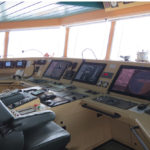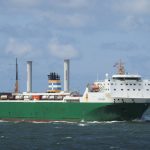Norsepower has developed the Rotor Sail technology. CTO Jarkko Väinämö talks about the advantages of the system and gives an outlook
The Rotor Sail technology is back in the shipping sector. For which types of vessels is it suitable?
Jarkko[ds_preview] Väinämö:
The first Rotor Sail was made in 2014. It was installed late in 2014 on the RoRo vessel »Estraden«, operated by Bore, and the additionally second one has followed one year after on the same vessel. But the technology suits almost any other ship type, except for container ships. It is especially for ships with a sufficent deck space and free airflow around the Rotor Sails like tankers, bulk carriers, RoRo and RoPax vessels. But there are ship-specific limitations, for example onboard cranes. The technology also suits passenger vessels because we are able to make those Rotor Sails low in noise and vibration. The vessels on which the Rotor Sails are to be installed should be no smaller that 2,000 dwt. Smaller vessels might have issues with stability and manoeuvrability etc. due to the large size of the Rotor Sails. It is always cheaper to manufacture larger Rotor Sails. They are an option for very big tankers or bulk carriers as well, because on these types of vessels there is plenty of space and more Rotor Sails can be installed. We are working on larger Rotor Sails at the moment.
Why did you chose a RoRo carrier for installing the prototype?
Väinämö:
Bore was interested in the technology and, additionally, the »Estraden« was a good fit because of how the ship is arranged. The wheel house and the accomodation block are located in the front and the Rotor Sails have been installed in the rear. There is no effect on the visibility or cargo handling for example.
How does the technology work?
Väinämö:
It is well known and it’s proven since about 100 years ago. But now we have developed a fully automated system. So it is modernized completely. The modern composite technologies are a true benefit and the answer to why it has become attractive again.
How did you modernize it?
Väinämö:
The working process of the Flettner Rotors is utilization of the Magnus effect. We developed a special method to manufacture the rotating part which is the most sensitive one. This part is a composite where no aluminium and no steel is being used. Additionally, the automation system and the software have been developed as well. The crew does not need to do anything else than to push one button. Then the systems detects the ambient conditions and controls the Rotor Sails accordingly. It even detects automatically when the ship is approaching a harbour and then shuts itself down. Additionally, with the specific manufacturing method we use with the composite rotors, it is now possible to produce it with very light weight and extremely well balanced. That means that we can rotate them faster with less energy. That makes the sails more efficient.
Are there more advantages to the system?
Väinämö:
The fuel consumption on »Estraden«, which has two smaller Rotor Sails, is reduced by 6,1%. That means 2t of fuel per sailing day, which is quite a lot. With the currently dropped fuel price it keeps a payback period below five years at the moment. With the Rotor Sail solution it is possible to achieve savings from 5 to 25% in fuel consumption. That depends on the number of Rotor Sails and their sizes, on the ship types and on the routes where they are operated. Furthermore, the system is easily retrofitable, because the foundation and the wiring can be done during a regular dry docking period. After that, the readymade and tested Rotor Sails can be installed within a few hours even while the ship can be loaded and unloaded at the same time.
What are the experiences of Bore with the Rotor Sail technology?
Väinämö:
I think Bore is very happy with it. When we developed the Rotor Sails, they actually offered us a test platform. But because the savings were so good, they decided to buy the system from us. So it is now owned by Bore.
Why is the system only used by one vessel at the moment?
Väinämö
: The shipping branche is more or less sceptic and conservative. They want to have very good proof first that the system works before they see a good business case in it. I think we have proven that it works and that good business cases to use it exist. But for sure, we need more references than just one for gaining a worldwide position as a mature technology.
Do you have more companies that are interested in the Rotor Sail technology?
Väinämö:
Yes, the interest is quite good. We are progressing with a few shipping companies and we hope to publish some new projects in the near future. It is a question of who the first movers are, who will try the technology next. But that is a problem for any new technology. There are also a lot of different battery systems and air bubbling systems and other stuff that is new on the market and in the same position as we are.
In which regions do the vessels have to sail for getting the greatest benefit?
Väinämö:
The better return of investment and the shorter pay-back period you get in the areas where you have the best winds. Typically the wind conditions are always better the further you go from the equator. Very good areas for example are Northern Atlantic, North Sea, Baltic Sea and Northern Pacific.
What are the future plans of Norsepower?
Väinämö:
Our vision is to become a global leader in auxiliary wind propulsion systems. The vision is also that Rotor Sail systems are used in large-scale in the future and that it would be normal to have a ship with Rotor Sails on it.
Do you think this scenario is realistic and in which period could your vision become reality?
Väinämö:
We have estimated the theoretical potential for the system to install it on up to 20,000 ships. Of course it will take a long time but we see 100 or 200 installations in six to seven years. That would be a good start.
Thomas Wägener






















